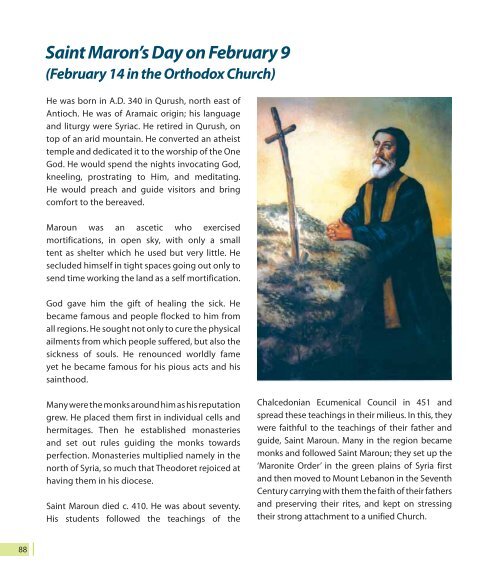Cultural aspects in Christian and Islamic religions - unesdoc - Unesco
Cultural aspects in Christian and Islamic religions - unesdoc - Unesco
Cultural aspects in Christian and Islamic religions - unesdoc - Unesco
You also want an ePaper? Increase the reach of your titles
YUMPU automatically turns print PDFs into web optimized ePapers that Google loves.
88<br />
Sa<strong>in</strong>t Maron’s Day on February 9<br />
(February 14 <strong>in</strong> the Orthodox Church)<br />
He was born <strong>in</strong> A.D. 340 <strong>in</strong> Qurush, north east of<br />
Antioch. He was of Aramaic orig<strong>in</strong>; his language<br />
<strong>and</strong> liturgy were Syriac. He retired <strong>in</strong> Qurush, on<br />
top of an arid mounta<strong>in</strong>. He converted an atheist<br />
temple <strong>and</strong> dedicated it to the worship of the One<br />
God. He would spend the nights <strong>in</strong>vocat<strong>in</strong>g God,<br />
kneel<strong>in</strong>g, prostrat<strong>in</strong>g to Him, <strong>and</strong> meditat<strong>in</strong>g.<br />
He would preach <strong>and</strong> guide visitors <strong>and</strong> br<strong>in</strong>g<br />
comfort to the bereaved.<br />
Maroun was an ascetic who exercised<br />
mortifications, <strong>in</strong> open sky, with only a small<br />
tent as shelter which he used but very little. He<br />
secluded himself <strong>in</strong> tight spaces go<strong>in</strong>g out only to<br />
send time work<strong>in</strong>g the l<strong>and</strong> as a self mortification.<br />
God gave him the gift of heal<strong>in</strong>g the sick. He<br />
became famous <strong>and</strong> people flocked to him from<br />
all regions. He sought not only to cure the physical<br />
ailments from which people suffered, but also the<br />
sickness of souls. He renounced worldly fame<br />
yet he became famous for his pious acts <strong>and</strong> his<br />
sa<strong>in</strong>thood.<br />
Many were the monks around him as his reputation<br />
grew. He placed them first <strong>in</strong> <strong>in</strong>dividual cells <strong>and</strong><br />
hermitages. Then he established monasteries<br />
<strong>and</strong> set out rules guid<strong>in</strong>g the monks towards<br />
perfection. Monasteries multiplied namely <strong>in</strong> the<br />
north of Syria, so much that Theodoret rejoiced at<br />
hav<strong>in</strong>g them <strong>in</strong> his diocese.<br />
Sa<strong>in</strong>t Maroun died c. 410. He was about seventy.<br />
His students followed the teach<strong>in</strong>gs of the<br />
Chalcedonian Ecumenical Council <strong>in</strong> 451 <strong>and</strong><br />
spread these teach<strong>in</strong>gs <strong>in</strong> their milieus. In this, they<br />
were faithful to the teach<strong>in</strong>gs of their father <strong>and</strong><br />
guide, Sa<strong>in</strong>t Maroun. Many <strong>in</strong> the region became<br />
monks <strong>and</strong> followed Sa<strong>in</strong>t Maroun; they set up the<br />
‘Maronite Order’ <strong>in</strong> the green pla<strong>in</strong>s of Syria first<br />
<strong>and</strong> then moved to Mount Lebanon <strong>in</strong> the Seventh<br />
Century carry<strong>in</strong>g with them the faith of their fathers<br />
<strong>and</strong> preserv<strong>in</strong>g their rites, <strong>and</strong> kept on stress<strong>in</strong>g<br />
their strong attachment to a unified Church.

















